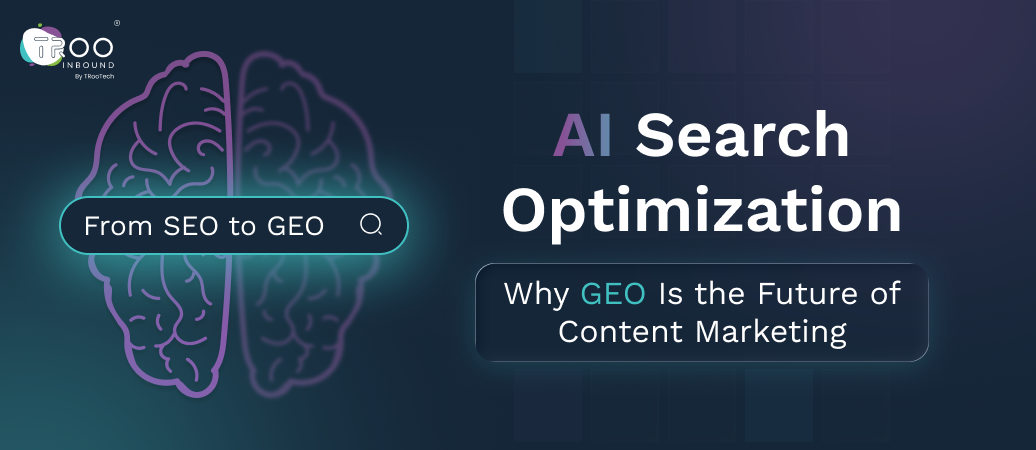Didn’t Discover!!
What You're Looking For?
Didn’t Discover!!
What You're Looking For?
Home Digital Marketing AI Search Optimization: Why GEO Is the Future of Content Marketing

 By
Aman Bhati
By
Aman Bhati
According to a survey report published by Innovating with AI, “83% of users prefer AI search over ‘traditional’ Googling.”
This shows how fast the search pattern is evolving. Back then, Google was the most popular search engine. But today we have AI search engines like ChatGPT, Gemini, Claude, Perplexity, etc.
To stay visible on Google and these AI search engines, you need more than traditional SEO. That’s where the AI search optimization (AISO) and its evolution, Generative Engine Optimization (GEO), enter.
These new SEO branches ensure that the content you write is included in the responses that AI search engines generate. So, let’s explore what AISO and GEO are, their connection, and why AI SEO experts say GEO is the future of content marketing.
AISO means optimizing content using specific tactics so AI-powered search systems can search, understand, and present it to users.
Think of AISO as optimizing for “answer engines” rather than “search engines.” Instead of fighting for ten blue links on page one, your goal is to select your content as the best response an AI tool serves up to a user query.
This process involves:
Generative Engine Optimization (GEO) is a specialized AISO branch that ensures your content is the source AI engines pull when generating responses, instead of just ranking #1 on Google.
For example:
When someone asks ChatGPT, “What’s the best CRM for small businesses?”, GEO ensures your content or product is cited.
If AISO is the broad discipline, GEO is its real-world marketing application—and it’s quickly becoming the foundation of future content marketing strategies.
For a deeper dive, check our blog on Generative Engine Optimization.
From the above sections, we can conclude that AISO and GEO work hand-in-hand:
AISO is about optimizing for AI search systems overall.
GEO is about optimizing specifically for AI-generated content engines.
Think of it this way:
SEO is for Google & Bing rankings.
AISO is for how AI engines discover and process your content.
GEO is for how your content appears in AI-powered answers.
Both are part of the evolution from traditional SEO > AI SEO > GEO.
GEO has become a survival technique for content marketers to prevent their content from vanishing from AI searches. Here’s why:
Creating a Generative Engine Optimization strategy doesn’t mean abandoning traditional SEO tactics, but it does demand a shift in mindset and strategy.
AI engines don’t “crawl and index” like Google—they analyze context, intent, and relevance. Study how ChatGPT, Perplexity, and SGE pull answers. Ask them your target queries to see which sources they trust.
AI loves clear, direct answers. Try to write in natural language, add FAQs, and other sections with conversational formats. Implementing these content tips rather than just keyword stuffing will benefit your site’s visibility on AI search engines.
Schema markup and structured metadata make understanding your content easier for AI systems. Product details, FAQs, and how-to guides should be schema-enabled.
Regularly test your brand visibility on AI platforms. If your content doesn’t show up, adjust your structure, tone, or authority signals. Think of this as answer engine optimization in practice.
Platforms like HubSpot give you topic cluster models, AI SEO recommendations, and analytics that help align content with GEO requirements. Integrating HubSpot SEO tools with your content marketing ensures your content is optimized for Google and AI engines.
Adapting to GEO requires a mix of AI SEO skills, technical optimization, and content strategy. This can be overwhelming for in-house teams. By choosing to hire SEO experts, you get the benefits of:
AI search optimization is not a one-time fix—it’s an ongoing process. Hiring specialists ensures your business stays ahead of competitors relying only on traditional SEO.
Search is no longer just about ranking high; it’s about being the trusted source AI engines choose. Generative Engine Optimization (GEO) is where content marketing is heading, blending AI search optimization with conversational, answer-driven visibility.
Brands that adopt GEO today will build authority in Google and across AI-driven answer engines tomorrow.
Whether you’re building a content marketing strategy, testing answer engine optimization, or ready to scale, GEO is the key to future-proofing your digital presence. And with the right team of AI SEO experts, you can make sure your content is always part of the conversation.
Here you'll find the answers to all of your questions.
Generative Engine Optimization (GEO) is the process of making your content more visible in AI-powered answer engines like Google SGE, ChatGPT, and Perplexity. Instead of just ranking on a search results page, GEO ensures your content is cited, referenced, or used directly in AI-generated answers.
Traditional SEO focuses on ranking high on Google or Bing results pages.
Yes. AI SEO tools make GEO much easier. Tools like SurferSEO, Clearscope, HubSpot SEO tools, or Jasper help you:
They don’t replace strategy but help you align faster with AI search optimization.
Not completely, at least not yet.
In the future, the two will likely work together as part of a modern AI-powered SEO strategy.
Here’s a simple 5-step approach:

Dive into other interesting, well-researched, and nicely structured blog posts
 a CTA
a CTAWe will strategize our execution based on your requirement
Stay up to date by subscribing to our newsletter.
5900 Balcones Drive STE 100, Austin, TX 78731
Velocity 904-910, L.P. Savani Road, Nr. Madhuvan Circle, Surat, Gujarat 395009
5900 Balcones Drive STE 100, Austin, TX 78731

Call
+91 27174 54342

Email Address
hello@trooinbound.com

Skype Id
nikhil.jani

Schedule A Meeting
meeting/nikhil-jani
Copyright © 2025, TRooInbound. All Rights Reserved.